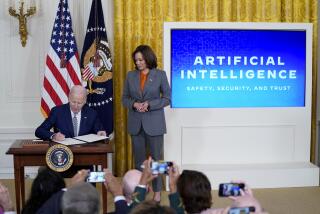A clearer picture
Shepard Fairey, a Los Angeles-based “street artist,” has made a career out of recycling other people’s images. His admirers say he uses familiar visual icons as a vehicle for political and cultural commentary, often in an arresting and subversive way. His critics cast his efforts in a more negative light, accusing him of blatantly plagiarizing images created by other artists, giving them neither credit nor royalties from the sales of his posters and other merchandise.
Fairey is now embroiled in a legal battle with the Associated Press over what are undoubtedly his best-known works of art to date: the “Hope,” “Change” and “Progress” posters he produced last year to support Barack Obama’s presidential campaign. The popular images were unmistakably drawn from a picture that AP contract photographer Mannie Garcia took of Obama at a National Press Club event in 2006. But Fairey used just a tracing of Obama from the initial shot, filling it in with broad strokes of color. The result conveys something much different from the photograph: hero worship, in the fashion of mid-20th century propaganda posters. Fairey claimed in federal court that he made a “fair use” of the photo and therefore wasn’t bound by the AP’s copyrights; the AP countersued, saying he infringed and must pay damages.
Fairey’s artistic techniques evoke a bygone era, but fair-use battles such as his are an increasingly common hallmark of these digital times. Powerful tools for copying and editing audio, images and video make it easier than ever for artists to use other people’s finished products as raw material for new renderings. Virtual guitars and other instruments can be created out of a few recorded notes. Cropped images and frames of video can be mixed like colors on a palette. In some cases, the initial work is unrecognizable in the new one; in others, it may be easily detected but the context is so different that the new work bears little relationship to the old.
Federal law provides general guidelines for determining whether the end results are legal or copyright infringements, including four factors to consider on claims of fair use. These are the nature of the initial work, such as whether it’s fiction or nonfiction; how much of it was reused; the purpose and transformative qualities of the new work; and whether the new work reduced the potential earnings of the initial one. Fairey’s battle with the AP raises another important issue: What aspects of a photograph can be copyrighted? By law, something can be copyrighted only if it contains some amount of creativity or originality. But the AP is effectively claiming copyright over an element that’s hardly original -- an outline of Obama’s features, removed from any hint of time, place or context.
Sadly, Fairey muddied the legal waters by lying to the court about which photo he used as the source for his posters. For months he claimed to have used just a portion of a larger photo, and he even fabricated evidence to support that claim. He eventually admitted the deception, and his first team of attorneys has since withdrawn from the case. It remains to be seen how his admission will affect the proceedings.
A key question, as with so many of these disputes, is how to distinguish between a derivative work and something so transformative that it’s a fair use. Copyright holders frequently argue that they’re entitled to share in the revenue generated by anything that’s built on one of their creations. Letting people reuse it for free, they say, diminishes the incentive for creating it in the first place. The framers of the Constitution were so concerned about that incentive that they gave Congress the power to grant inventors and authors exclusive rights over their works in order to “promote the progress of science and the useful arts.” But there’s a difference between preserving the incentive to create and letting creators collect a toll from every author or artist who builds on what they’ve done. And it’s hard to see how the incentive to take news photos is diminished when generic head-shots are stylized into evocative campaign posters.
The Constitution makes clear that copyright laws are supposed to encourage creativity and innovation rather than restraining them. Giving the green light to truly transformative efforts -- ones that change the context or substance so dramatically that they don’t affect the market for the initial work -- should lead to more art, not less. It’s not easy to define what makes a use so transformative, nor is that the only consideration. The complexity of the judgment is why the courts decide fair-use questions on a case-by-case basis, with individual rulings helping to chart a rough dividing line between acceptable uses and infringements. The dispute between Fairey and the AP offers a chance to make that line a bit clearer. We don’t think the court should condone his deception -- some kind of sanction would be appropriate. Yet that should not tip the balance the court must strike between creators and those who follow them.
More to Read
The biggest entertainment stories
Get our big stories about Hollywood, film, television, music, arts, culture and more right in your inbox as soon as they publish.
You may occasionally receive promotional content from the Los Angeles Times.










